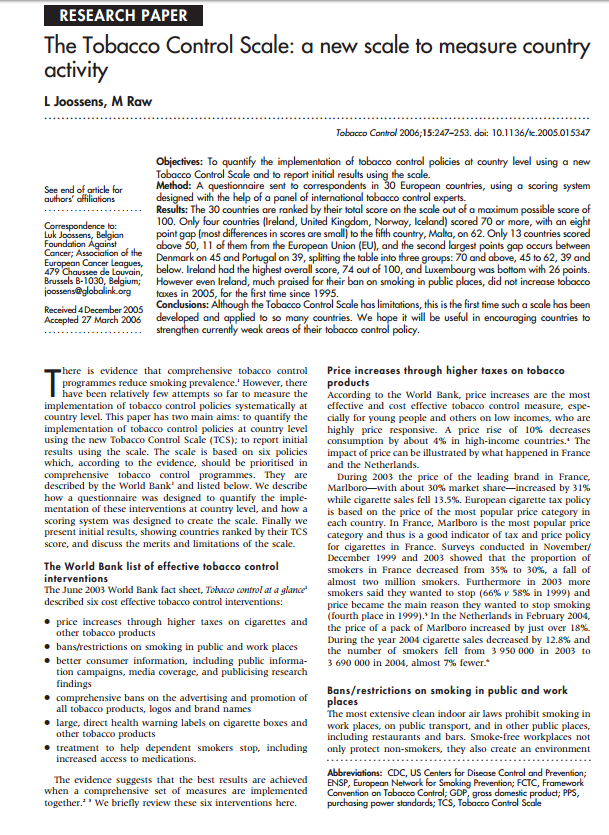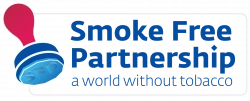METHODS
In 2004 the European Network for Smoking Prevention (ENSP), with financial support from the European Commission, provided a grant to one of the authors, Luk Joossens to measure tobacco control activity at country level in Europe. A questionnaire was drafted then finalised with feedback from a panel of experts (Table 1). In 2004 the questionnaire was sent to the ENSP correspondents in 28 countries who had agreed to fill in their country data. They were nominated by ENSP because they were the official country representatives to ENSP, members of their national coalition and thus knowledgeable about tobacco control (Table 2). The questionnaire was sent to the 25 countries of the European Union (EU) plus Iceland, Norway and Switzerland (Table 3).
Although the original intention of the project was simply to describe current tobacco control policies in Europe, it seemed worthwhile trying to quantify these policies, in order to compare countries more systematically. However, while we have evidence telling us broadly which tobacco control measures are effective, it is not easy to decide what weight should be given to each policy in a scale. This might be decided by the size of the effect of a policy measure, but relatively little rigorous research on the effectiveness of tobacco control policy exists, and such research that does exist is not precise enough to permit easy comparisons between countries.
Therefore, in order to score the questionnaire and create the scale we had to assign scores to each tobacco control policy. To do this ENSP convened a panel of experts to agree the allocation of points to the scale. The panel exchanged emails from January to April 2004 and some of them met during an ENSP meeting in Krakow in May 2004. The panel included a leading American tobacco control economist, who was the World Bank representative to the World Health Organization Framework Convention on Tobacco Control (FCTC) negotiations in Geneva, and tobacco control experts from different regions in Europe. On average the participants had more than 20 years experience in tobacco control. They contributed mostly to the weighting of price, smoke-free policies and advertising, mainly by email. None refused to join the project.
In summer 2005 the questionnaire survey was repeated with 30 European countries: the previous 28 plus two accession countries, Bulgaria and Romania. Data were collected using the 2004 questionnaire, but stricter definitions were applied in the scale to smoke-free places and smoking treatment systems.

The Tobacco Control Scale: a new scale to measure country activity
DownloadThe scale
The questionnaire and raw data are available on the Tobacco Control website, showing the points allocated to each policy, with a maximum potential score of 100, is shown in table 3. The right column/blue rows show the maximum points that can be scored for each policy. The questionnaire asked about legislation in force on the 1 July 2005, price data on 1 January 2005, and the 2004 tobacco control budget. Thus any legislation, price increases or funding introduced after those dates, as has happened or will happen for example in Spain, Scotland, Estonia, Belgium and England, are not included.
The following data sources (apart from the questionnaire) were used to score the scale:
- The price of a pack of Marlboro (20 pieces) on 1 January 2005 was based on a Citigroup Smith Barney report.
- The price of a pack of 20 cigarettes in the most popular price category on 1 January 2005 was based on the 2005 European Commission report ‘‘Excise duty tables’’
- Gross domestic product (GDP) expressed in purchasing power standards (PPS) per capita and GDP in 2004, and country population data on 1 January 2004 were collected from the statistical office of the European Union.
- Information on legislation obtained from the correspondents via the questionnaire was discussed and verified at the WHO tobacco legislation database during a visit to the European regional office in July 2005; provisional scores were sent in July 2005 to the 30 country correspondents for comment.
The most common problem in assigning points remained the subjectivity involved in assessing enforcement/implementation. For example, there is room for interpretation of the extent to which a law is enforced or what for a treatment system constitutes ‘‘selected areas’’ or ‘‘the whole country’’. We relied on the judgement of our correspondents, familiar with the situation in their country. Although we think the most accurate and reliable data are likely to come from experienced tobacco control professionals in their own country, we acknowledge that this scale depends critically on their judgement, and that in principle it would be worthwhile developing more sophisticated measures of implementation.
Changes in the methodology
In the 2007 survey most of the data were collected through a questionnaire which relied principally on the expert judgement of the correspondents who completed it. This proved problematic where judgements were required of, for example, whether smoke-free legislation was well enforced or not. In the current survey we have reduced the subjectivity in these judgements by using the results of the Eurobarometer surveys to evaluate the enforcement of the smoke-free legislation. The methodology and rationale of the scale has been changed in two occasions: in 2010 and 2019. The changes to the scale items and scoring were agreed in May 2010 by the following European tobacco control experts: Ann McNeill (UK Centre for Tobacco Control Studies, University of Nottingham, UK), Yves Martinet (Comité National contre le Tabagisme, France), Marc Willemsen (Stivoro, Netherlands), Cornel Radu (ENSP, Brussels), Florence Berteletti Kemp (Smoke-Free Partnership, Brussels), Luk Joossens (ECL, Brussels), and Martin Raw (UK Centre for Tobacco Control Studies, University of Nottingham, UK). In 2019, changes were agreed by: Luk Joossens (ECL, Brussels), Ariadna Feliu (Institut Català d’Oncologia, L'Hospitalet del Llobregat) and Esteve Fernández (Institut Català d’Oncologia, L'Hospitalet del Llobregat).
PRICE
· 2007: The country with the highest prices and tobacco control budgets received maximum points.
· 2010: The country whose pack price was €7.5 received 15 points, taking into account affordability, measured by Purchasing Power Standards (PPS).
· 2019: The country with a Weighted Average Price of €10 a pack and an EU average PPS receives 30 points.
· 2021: The country with the Weighted Average Price of 18 International dollars (I$) for cigarettes in 2020 receives 30 points. The Purchasing Power Parity here was expressed in international dollars as used by the World Health Organisation in its report The Global Tobacco Epidemic 2021.
SMOKE-FREE PUBLIC/WORKPLACES
· 2007: The information on legislation was obtained from the correspondents via the questionnaire.
· 2010: The Eurobarometer survey was used to evaluate the enforcement of the smoke-free legislation.
· 2021: The information on legislation was obtained Smoke Free Partnership, 2022 Smoke Free Map.
BUDGET
· 2010: In 2007 spending totals included spending on tobacco dependence treatment services, but these were removed from the 2010 total, because funding for cessation services is already taken into account in the section on treatment.
· 2019: Five points were removed from this component to add two new components in the scale.
ADVERTISING AND PROMOTION BANS
· 2010: Two points were added for a ban on the display of tobacco products at point-of-sale and one point for standardized packaging (which means only one standardised form and size of cigarette packs).
HEALTH WARNING
· 2010: There are four points newly awarded for plain packaging, because of which the other points were reduced.
TREATMENT
· 2010: One point is allocated for the recording of smoking in medical notes, and one point for reimbursement of family doctors for providing brief advice. Small changes were made to the quit line definition.
In 2019, we made some changes in scoring system by adding two new components:
· Illicit tobacco trade: Three points added 3 points for combating illicit tobacco trade.
· Tobacco Industry interference: Two points for controlling tobacco industry interference. Countries who ratified the International Protocol to Eliminate the Illicit Trade of Tobacco Products (the WHO FCTC Protocol) received 1 point. A track and trace system for tobacco products, fully FCTC Protocol compliant, is 2 points and a track and trace system for tobacco products, but not fully FCTC Protocol compliant, would be 1 point.
· Those countries who have not ratify the WHO Framework Convention on Tobacco Control lose one point.



The Tobacco Control Scale is partly funded by operating funding from the European Commission to Smoke Free Partnership. The views expressed in this website do not necessarily reflect the official views of the European Union institutions.
Copyright 2022 © All Rights Reserved


